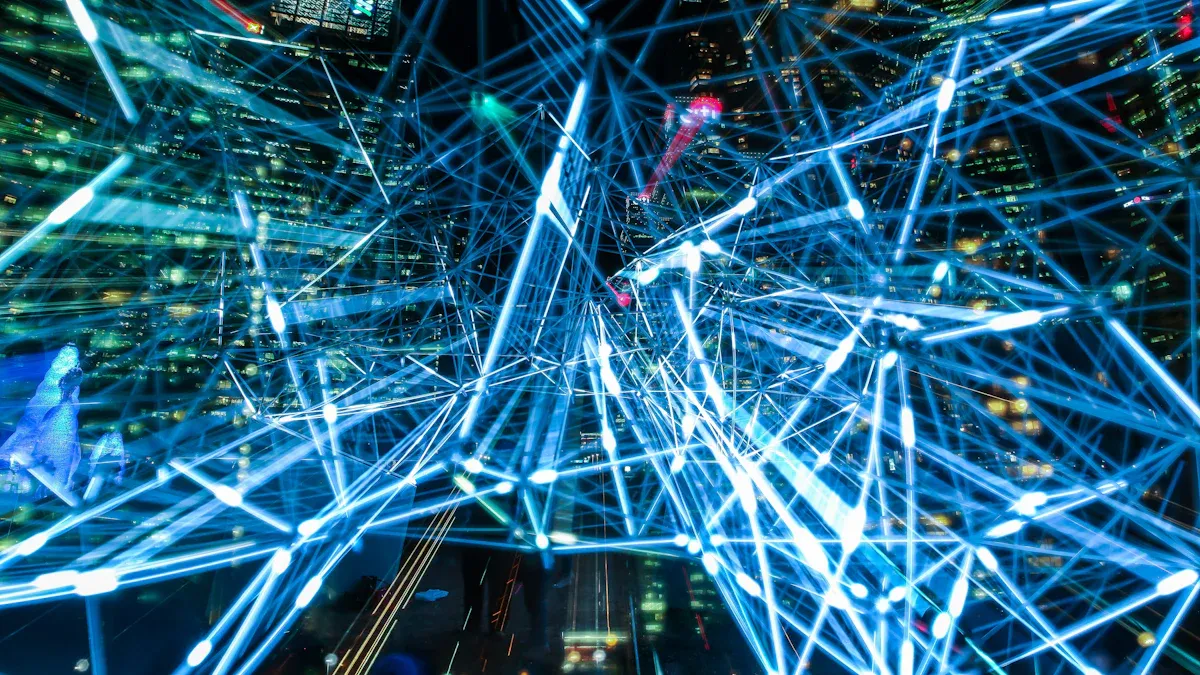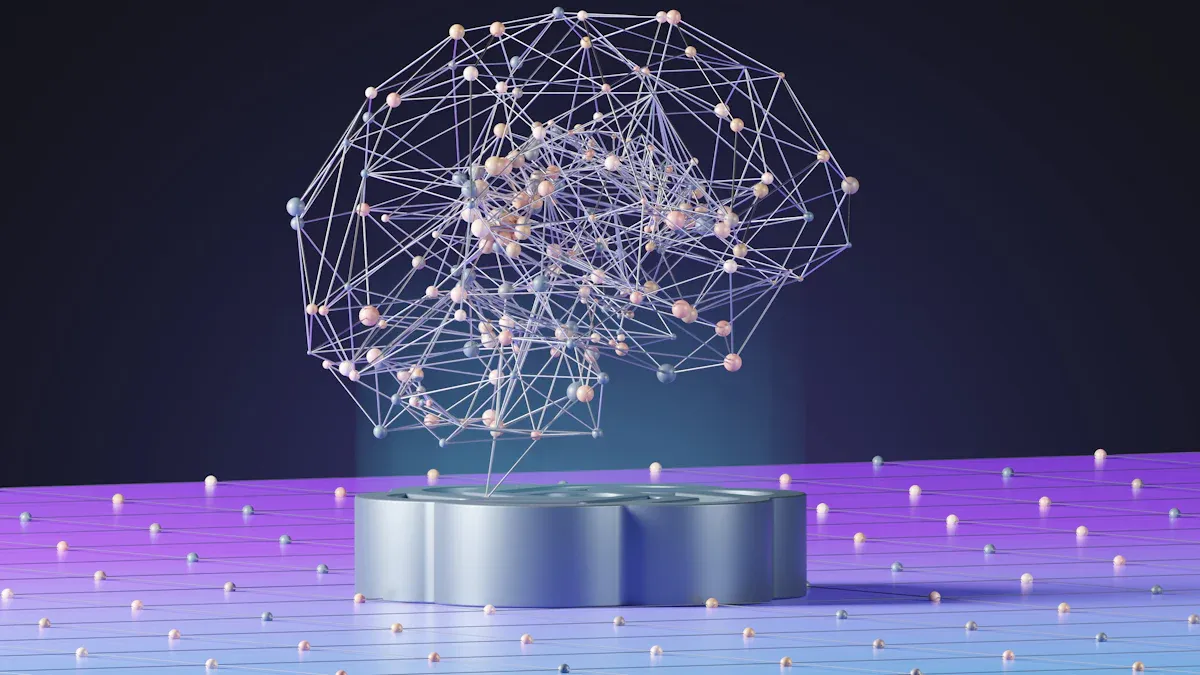
AI is changing how you approach video editing. In 2025, advanced tools use AI to handle tedious tasks, letting you focus on creativity. These tools analyze your footage, suggest edits, and even generate new content. AI Video Editing makes processes faster and smarter, helping creators produce high-quality videos with less effort. Whether you're a professional or a beginner, this technology ensures you can create videos that captivate your audience.
AI isn't just a tool; it's a creative partner that transforms your video projects into compelling stories.
Key Takeaways
-
AI tools handle boring editing tasks, so you can be creative.
-
Custom video content keeps viewers interested and makes videos better.
-
Editing in real-time helps you work faster with great results.
-
AI makes pro editing tools easy for beginners and small creators.
-
Use AI to boost your stories while keeping your own style.
The Impact of AI on Video Editing
Streamlining the Editing Process
AI has revolutionized how you approach video editing by automating time-consuming tasks. In 2025, ai-powered editing tools analyze your footage and handle repetitive processes like cutting, trimming, and organizing clips. This allows you to focus on the creative aspects of your project. For example, AI can automatically remove background noise from audio tracks or correct color imbalances in your footage. These tasks, which once required hours of manual effort, now take only minutes.
AI-based video editing also introduces real-time enhancements during recording and streaming. This innovation transforms live broadcasts and video conferencing by improving video quality on the fly. Whether you're a professional editor or a content creator, these advancements save you time and ensure your videos maintain a polished, professional look.
Enhancing Creativity with AI-Powered Tools
AI isn't just about efficiency; it's also a powerful ally in boosting your creativity. AI-powered editing tools can perform style transfers, enabling your videos to mimic artistic styles like impressionism or modern art. This feature enhances the visual appeal of your content and helps you stand out in a crowded digital landscape.
AI can also generate special effects, such as realistic rain or snow, to enrich your storytelling. Imagine creating a dramatic scene with lifelike weather effects without needing expensive equipment or hours of post-production work. Additionally, AI-powered deblurring algorithms restore clarity to footage with motion blur, making it ideal for action-packed scenes.
Another exciting development is AI inpainting, which removes unwanted objects from your videos. Whether it's a stray microphone in the frame or an accidental passerby, AI handles these distractions seamlessly. These tools empower you to bring your creative vision to life without technical limitations.
Making Video Editing Accessible to All
AI video editing has democratized video creation, making it accessible to everyone, regardless of skill level. In the past, editing required specialized knowledge and expensive software. Today, AI-powered editing tools simplify the process, allowing beginners to create professional-quality videos with ease.
For instance, AI-generated video clips from text descriptions streamline content creation. You can type a description, and AI will produce a corresponding video, perfect for rapid prototyping or brainstorming. This feature is especially useful for small businesses and independent creators who lack the resources for traditional production methods.
AI video trends in 2025 also include hyper-personalization, where AI tailors videos to specific audiences. This ensures your content resonates with viewers, increasing engagement and impact. By removing barriers to entry, AI fosters a more inclusive environment for creators of all backgrounds.
Key AI Video Trends in 2025
Automated Editing and Smart Features
AI has redefined how you approach video editing by introducing automated tools and smart features. These innovations handle repetitive tasks like trimming, sequencing, and syncing audio, allowing you to focus on storytelling. For instance, AI-based video editing tools can analyze your footage and suggest the best cuts or transitions. This not only saves time but also ensures a polished final product.
Smart features like auto-captioning and voice recognition have become standard in 2025. These tools generate accurate subtitles and transcriptions, making your videos more accessible to diverse audiences. Additionally, AI-powered scene detection identifies key moments in your footage, helping you create highlight reels effortlessly.
The efficiency and speed of these tools are unmatched. You can now produce high-quality videos in a fraction of the time it once took. This trend has made video creation more scalable, enabling creators to meet the growing demand for content without compromising quality.
AI-Generated Content and Synthetic Media
AI-generated video content is one of the most exciting trends in 2025. With advancements in synthetic media, you can create entire videos from scratch using AI. These tools generate realistic visuals, animations, and even AI voices and avatars, opening up new creative possibilities. For example, AI-generated b-roll videos can fill gaps in your footage, ensuring seamless transitions and a professional look.
Synthetic media also allows you to experiment with styles and techniques that were previously out of reach. Imagine creating a futuristic cityscape or a historical reenactment without needing expensive sets or equipment. AI makes these scenarios achievable, reducing costs and expanding your creative horizons.
However, the rise of synthetic media also raises ethical questions. As a creator, you must consider how to use these tools responsibly. Transparency about AI-generated elements in your videos can help maintain trust with your audience.
Personalized Videos for Targeted Audiences
Personalization has become a cornerstone of video editing trends in 2025. AI enables you to tailor videos to individual viewers, enhancing engagement and impact. For example, AI can analyze user data to create personalized video recommendations or even unique video versions for different audience segments.
This level of customization is particularly valuable for businesses. You can use AI to craft marketing videos that speak directly to your target audience, increasing conversion rates. Personalized videos also improve viewer retention, as they resonate more deeply with your audience's preferences and interests.
AI's ability to scale personalization without sacrificing quality is a game-changer. Whether you're creating content for social media, e-learning, or advertising, AI ensures your videos connect with viewers on a personal level.
Tip: Leverage AI's personalization capabilities to build stronger relationships with your audience and stand out in a crowded digital landscape.
Real-Time Editing for Faster Turnarounds
Real-time editing has become a game-changer in 2025, revolutionizing how you approach video creation. This innovation allows you to make edits instantly, eliminating the need for lengthy post-production processes. Whether you're working on live broadcasts, social media content, or corporate videos, real-time editing ensures faster turnarounds without compromising quality.
One of the most significant advantages of real-time editing is its ability to enhance efficiency. You can adjust visuals, audio, and effects while recording or streaming. For example, AI-powered tools can automatically correct lighting or stabilize shaky footage as you shoot. This feature saves time and ensures your video looks polished from the start.
Note: Real-time editing tools are ideal for creators who need to meet tight deadlines or produce content on the fly.
Key Features of Real-Time Editing
Real-time editing tools offer several features that simplify your workflow:
-
Live Color Grading: Adjust colors and tones during recording to achieve the desired look instantly.
-
Instant Effects Application: Apply filters, transitions, and overlays in real-time, reducing post-production work.
-
AI-Assisted Scene Adjustments: Use AI to detect and enhance specific scenes, such as improving clarity in low-light conditions.
-
Dynamic Audio Editing: Balance audio levels and remove background noise while capturing footage.
These features empower you to focus on storytelling rather than technical details, making video creation more accessible and efficient.
Applications in Different Industries
Real-time editing isn't limited to one field. Its versatility makes it valuable across various industries:
|
Industry |
Application |
|---|---|
|
Social Media |
Create engaging short-form videos with instant edits for platforms like TikTok. |
|
Education |
Produce e-learning videos with real-time adjustments for better clarity. |
|
Marketing |
Develop promotional content quickly to respond to market trends. |
|
Entertainment |
Stream live events with professional-quality visuals and audio. |
These applications highlight how real-time editing adapts to different needs, ensuring high-quality results regardless of the project.
The Role of AI in Real-Time Editing
AI plays a crucial role in enabling real-time editing. AI-based video editing tools analyze footage as you record, making intelligent suggestions and automating adjustments. For instance, AI can detect faces and apply focus enhancements or track objects to ensure smooth transitions.
AI also supports real-time editing by integrating predictive analytics. These tools anticipate your editing needs based on previous projects, streamlining your workflow further. As a result, you can produce videos faster while maintaining creative control.
Tip: Explore AI video trends to discover tools that align with your editing goals and maximize efficiency.
Real-time editing has transformed video creation, making it faster, smarter, and more accessible. By leveraging AI and advanced tools, you can meet the growing demand for high-quality content without sacrificing creativity or precision.
Emerging Technologies in AI Video Editing

VR and AR Integration in Editing
Virtual Reality (VR) and Augmented Reality (AR) are reshaping how you approach video creation. These technologies allow you to create immersive and interactive experiences that captivate audiences. In 2025, VR and AR tools have become more accessible, enabling you to edit videos in three-dimensional spaces. For example, you can manipulate objects, adjust lighting, or add effects directly within a virtual environment.
AR also enhances real-world video editing by overlaying digital elements onto live footage. Imagine adding animated characters or interactive graphics to your videos in real time. These features are particularly valuable for industries like gaming, education, and marketing, where engaging visuals are essential.
Tip: Explore VR and AR tools to elevate your storytelling and create unforgettable video experiences.
AI Optimization for 8K and Beyond
The rise of 8K resolution has set new benchmarks for video quality. AI plays a crucial role in optimizing editing workflows for such high-definition content. Advanced algorithms analyze footage to enhance details, reduce noise, and ensure smooth playback, even for large files.
AI-powered tools also simplify the editing process for 8K videos. For instance, they can automatically adjust color grading, upscale lower-resolution footage, and stabilize shaky shots. These features save you time and ensure your videos meet modern quality standards.
As 8K becomes the norm, AI will continue to evolve, supporting even higher resolutions and pushing the boundaries of visual storytelling.
Advanced Motion Tracking and Effects
Motion tracking has reached new heights with AI advancements. In 2025, AI-powered tools can track objects and movements with unparalleled precision. This capability allows you to add dynamic effects, such as text that follows a moving subject or realistic explosions synced with action scenes.
AI also simplifies complex tasks like rotoscoping, where you isolate objects from their backgrounds. With AI, you can achieve this in minutes instead of hours. These tools empower you to create visually stunning videos without requiring advanced technical skills.
Note: Advanced motion tracking is ideal for creating professional-quality videos in industries like film, advertising, and social media.
Applications of AI Editing in Social Media

AI Tools for Short-Form Content Creation
Short-form videos dominate social media platforms in 2025. AI tools simplify video creation by automating complex tasks. These tools help you produce engaging content quickly, even if you lack technical skills. For example, AI can analyze your footage and suggest the best cuts, transitions, and effects for platforms like TikTok or Instagram Reels.
AI-powered templates make editing faster. You can select a template, upload your clips, and let AI handle the rest. These templates include pre-designed transitions, captions, and music tracks tailored for short-form videos. This approach saves time and ensures your content looks professional.
AI also enables you to experiment with creative features. For instance, you can use AI to add dynamic text overlays or animated stickers that match the mood of your video. These features make your content more engaging and help you stand out in crowded feeds.
Enhancing Engagement with AI Analytics
AI analytics tools transform how you measure and improve video performance. These tools analyze viewer behavior, helping you understand what works and what doesn’t. For example, AI can track metrics like watch time, click-through rates, and audience retention.
You can use this data to optimize your videos. If viewers drop off at a specific point, AI suggests edits to improve pacing or content flow. This ensures your videos keep viewers engaged from start to finish.
AI also helps you personalize content for your audience. By analyzing user preferences, AI recommends topics, styles, or formats that resonate with your viewers. This level of customization boosts engagement and builds stronger connections with your audience.
Tip: Use AI analytics to refine your video strategy and maximize impact on social media.
Automating Video Production for Social Platforms
AI automates video production, making it easier to create content for multiple social platforms. You can use AI to resize and reformat videos for different platforms, ensuring they meet specific requirements. For example, AI can adjust your video’s aspect ratio for Instagram Stories, YouTube Shorts, or Facebook posts.
AI also streamlines captioning and subtitling. These tools generate accurate captions in multiple languages, making your videos accessible to global audiences. Additionally, AI can suggest hashtags and keywords to improve discoverability on social media.
Automation extends to scheduling and posting. AI tools can analyze the best times to share your videos based on audience activity. This ensures your content reaches viewers when they’re most active, increasing visibility and engagement.
Note: Automating video production allows you to focus on creativity while AI handles technical details.
Benefits and Challenges of AI Video Editing
Benefits: Efficiency, Cost Savings, and Scalability
AI video editing tools in 2025 have transformed how you approach video creation. These tools streamline workflows, saving time and boosting efficiency. Tasks like trimming clips, syncing audio, and applying effects now take minutes instead of hours. This allows you to focus on storytelling rather than technical details.
AI also reduces costs. You no longer need expensive equipment or large teams to produce high-quality videos. Automated processes handle repetitive tasks, cutting production expenses significantly. For small businesses and independent creators, this makes professional video creation more accessible.
Scalability is another major advantage. AI-powered tools enable you to produce more videos in less time. Whether you're creating content for social media, marketing campaigns, or e-learning platforms, AI ensures you meet growing demands without sacrificing quality.
Tip: Use AI tools to maximize efficiency and scale your video production while keeping costs low.
Challenges: Ethical Concerns and Creative Balance
AI video editing raises important ethical and creative questions. Automation in creative processes challenges the idea of originality and authorship. For example, when AI generates content, who owns the creative rights? These questions are critical as AI continues to shape the industry.
Concerns about job displacement also emerge. Human editors face competition from AI tools that perform tasks faster and cheaper. This shift impacts the creative balance, as automation may overshadow human input.
Other ethical debates focus on the nature of creativity itself. AI blurs the line between human artistry and machine-generated content. Striking a balance between automation and creativity is essential to preserve the integrity of video editing as an art form.
-
AI challenges originality and authorship in creative industries.
-
Job displacement among human editors raises concerns.
-
Balancing automation and creativity remains a central issue.
Addressing Over-Reliance on Automation
While AI simplifies video editing, relying too much on automation can limit your creative potential. Overuse of AI tools risks producing generic content that lacks a personal touch. To avoid this, you should treat AI as a partner rather than a replacement.
Incorporating human creativity ensures your videos stand out. For example, while AI can suggest edits, your input adds emotional depth and storytelling elements. Combining AI's efficiency with your creative vision leads to more impactful results.
Note: Balance automation with human creativity to maintain originality and authenticity in your videos.
AI tools also require oversight. Automated processes may occasionally make errors, such as misinterpreting footage or applying incorrect effects. Regular reviews and adjustments ensure your videos meet your standards.
By using AI thoughtfully, you can harness its benefits without compromising your creative identity. This approach helps you create videos that resonate with audiences while maintaining artistic integrity.
Future Predictions for AI Video Editing
Hyper-Personalized Content Creation
In 2025, hyper-personalized video experiences have become the norm. AI analyzes viewer preferences, behaviors, and demographics to create videos tailored to individual needs. You can use this technology to deliver content that resonates deeply with your audience. For example, AI can adjust the tone, visuals, or even the storyline of a video based on the viewer’s profile.
This level of personalization enhances engagement. Imagine creating personalized videos for marketing campaigns where each viewer feels the message speaks directly to them. AI makes this possible by automating the process, saving you time while increasing impact. Hyper-personalization also benefits e-learning platforms, allowing educators to craft lessons that match each student’s learning style.
Tip: Use AI-driven personalization to strengthen connections with your audience and boost retention rates.
AI as a Creative Partner for Storytelling
AI has evolved into more than just a tool; it’s now your creative partner in storytelling. By analyzing your footage and understanding narrative structures, AI suggests edits, transitions, and effects that enhance your story. You can rely on AI to identify emotional beats in your video and amplify them with music or visuals.
AI also helps you experiment with new storytelling techniques. For instance, it can generate alternate endings or suggest creative ways to present your content. This collaboration allows you to push the boundaries of video creation while maintaining your unique voice.
Note: Treat AI as a collaborator that complements your creativity rather than replacing it.
The Evolution of AI-Driven Video Ads
AI-driven video ads are transforming the advertising landscape. In 2025, these ads use AI to analyze consumer data and craft messages that align with viewer preferences. You can create ads that feel less intrusive and more relevant, increasing the likelihood of conversions.
AI also optimizes ad placement and timing. By studying audience behavior, it determines the best moments to display your ads for maximum impact. Additionally, AI automates the production of ad variations, allowing you to test different approaches and refine your strategy.
This evolution makes video ads more effective and accessible. Whether you’re a small business or a global brand, AI empowers you to reach your audience with precision and creativity.
Tip: Leverage AI-driven ads to stay competitive in the fast-paced world of digital marketing.
AI is revolutionizing video editing in 2025, making it faster, smarter, and more accessible than ever. Automated editing, personalized videos, and VR/AR integration are reshaping how you create and consume content. The AI in video editing market is projected to grow to USD 4.4 billion by 2033, reflecting its transformative impact. From preproduction to postproduction, AI enhances creativity, efficiency, and precision. While challenges like ethical concerns remain, embracing AI ensures you stay competitive. The future of video editing lies in blending human creativity with AI innovation to craft compelling stories.
FAQ
What is AI video editing?
AI video editing uses artificial intelligence to automate and enhance video production. It handles tasks like trimming, color correction, and adding effects. These tools analyze footage and make intelligent suggestions, saving you time and improving the quality of your videos.
Can beginners use AI-powered editing tools?
Yes! AI tools simplify video editing for everyone. They offer user-friendly interfaces and features like auto-editing and templates. Even if you’re new to editing, these tools help you create professional-quality videos with minimal effort.
How does AI improve video personalization?
AI analyzes viewer data to tailor videos to individual preferences. It adjusts elements like tone, visuals, or pacing to match audience interests. This personalization boosts engagement and ensures your content resonates with viewers.
Are AI-generated videos ethical?
AI-generated videos raise ethical concerns, especially around transparency and originality. You should disclose AI’s role in your content and ensure it aligns with your creative vision. Responsible use of AI builds trust with your audience.
What industries benefit most from AI video editing?
AI video editing benefits industries like marketing, education, entertainment, and social media. Marketers use it for personalized ads, educators for e-learning content, and creators for engaging social media videos. Its versatility makes it valuable across various fields.
Tip: Explore AI tools tailored to your industry to maximize their potential.






